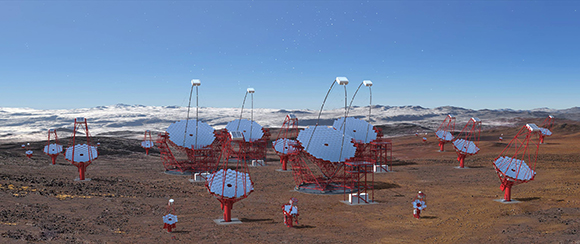Menu
Rechercher
Accueil > Rayonnement Cosmique et Matière Noire > CTA > CTA
CTA
by Julien Bolmont - 19 April 2022

Since the 2000s, ground-based gamma-ray astronomy has experienced major breakthroughs and spectacular results, obtained with the new generation of instruments such as H.E.S.S., MAGIC, VERITAS and HAWC. The main achievements of these projects concerns the first very high-energy gamma-ray survey of the inner part of our Galaxy, which revealed many new sources such as shell type supernova remnants, pulsar wind nebulae, star-forming regions and binary systems. Beyond our Galaxy, these instruments also probe other cosmic accelerators such as starburst galaxies or active galactic nuclei. Given their extreme variability, the latter in particular provide valuable insight on the precise localisation of the gamma-ray emitting zone and the acceleration mechanisms at work within their relativistic jets. The discovery potential and related physics studies with gamma rays has been proven, not only in the field of astrophysical observations, but also in fundamental physics and cosmology.
The Cherenkov Telescope Array (CTA) is the major next-generation facility for ground-based gamma-ray astronomy. It will be composed of two arrays: the first one in the Northern hemisphere, covering the full proposed energy range, from a few tens of GeV up to about 100 TeV, will be devoted to in-depth studies of Galactic sources, of the central part of our Galaxy, and also to observations of extragalactic objects. The other array, based in the Southern hemisphere and focused on the low energies (from a few tens of GeV to about 10 TeV) will be mainly dedicated to extragalactic studies. Each array will be constituted of two to three different types of Cherenkov telescopes of distinct sizes, operating together so as to deliver the optimal sensitivity, angular and energy resolution throughout the broad energy range that CTA will cover.
The CTA observatory, with its two sites, will be exploited by a unique consortium. A significant fraction of the observation time will be open to the international community and the observatory will have its own facilities of user support.
The scientific goals of the CTA project can be defined in three main topics: understanding the origin of cosmic rays and their impact on the Universe’s constituents, revealing the nature and variety of cosmic particle accelerators, and finally searching for the ultimate nature of dark matter and studying physical phenomena beyond standard models.
On the technical side, the laboratory is in charge of the design of the front end electronic board - with its firmware and software environment - of the NectarCAM camera, which will be deployed on the medium-sized telescopes of the Northern site of CTA.
Contact : Jean-Philippe Lenain, +33 1 44 27 39 14
Photo credit : ©CTA
Also in this section :









